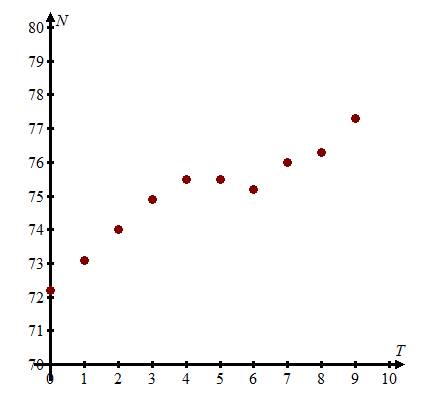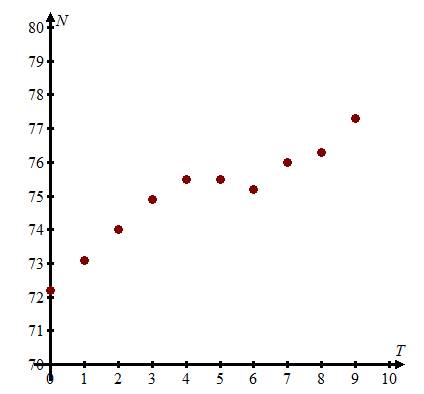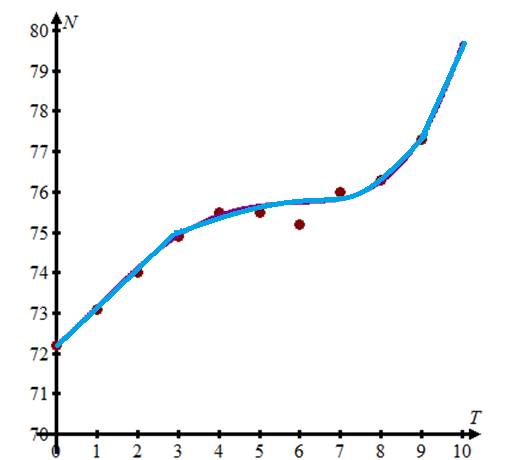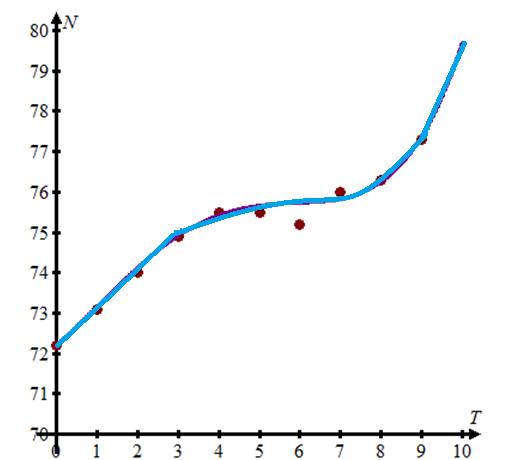
a.
To create a
a.
Answer to Problem 79E

Explanation of Solution
Given information:
The number
Use a graphing data utility to create a scatter plot of the data. Let
Calculation:
Here, we will consider the following table:

Hence, the result is shown in the graph.
b.
To find a quartic model for the data by using regression feature of the graphing utility.
b.
Answer to Problem 79E
Explanation of Solution
Given information:
The number
Use the regression feature of the graphing utility to find a quartic model for the data. (A quartic model has the form
Calculation:
By using the regression feature of the graphing utility a quartic model for the data is given by:
Hence, the result is
c.
How well does the model fit the data?
c.
Answer to Problem 79E

Explanation of Solution
Given information:
The number
Graph the model and the scatter plot in the same viewing window. How well does the model fit the data?
Calculation:
The graph of the model on the same scatter plot is shown below:

Hence, from the above graph we can observe that the model fits the data very closely.
d.
To find when did the number of students enrolled in the schools exceed
d.
Answer to Problem 79E
Explanation of Solution
Given information:
The number
According to the model, when did the number of students enrolled in the schools exceed
Calculation:
Hence, by using the zoom and trace features, the number of students enrolled in schools exceeded
e.
To find if the model is valid for long-term predictions of student enrollment?
e.
Answer to Problem 79E
No, the model is not valid.
Explanation of Solution
Given information:
The number
Is the model valid for long-term predictions of student enrollment? Explain.
Calculation:
No, the model is not valid for long-term predictions of student enrollment. As, the numbers predicted by the model increase very fast while estimated far into the future which may not be correct.
Hence, the model is not valid for long-term predictions of student enrollment.
Chapter 2 Solutions
EBK PRECALCULUS W/LIMITS
- #2arrow_forward2. We want to find the inverse of f(x) = (x+3)² a. On the graph at right, sketch f(x). (Hint: use what you know about transformations!) (2 points) b. What domain should we choose to get only the part of f (x) that is one- to-one and non-decreasing? Give your answer in inequality notation. (2 points) - c. Now use algebra to find f¯¹ (x). (2 points) -4- 3- 2 1 -4 -3 -2 -1 0 1 -1- -2- --3- -4 -N- 2 3 4arrow_forward1. Suppose f(x) = 2 4 == x+3 and g(x) = ½-½. Find and fully simplify ƒ(g(x)). Be sure to show all x your work, write neatly so your work is easy to follow, and connect your expressions with equals signs. (4 points)arrow_forward
- Find the one sided limit Tim f(x) where f(x)= (2x-1 X>1+ *arrow_forwardFind the limit lim X-700 4 13x-15 3x4+x³-12arrow_forwardFind the slope of the line secant to the curve F(x) = 13-x³ (from x=1 to x=2]arrow_forwardFind the ONe sided limit lim 2x X-2 1-xarrow_forwardFor each function, identify all points of discontinuity and label them as removable, jump, or infinite. A) f(x) = x-4 (X+15)(x-4) B) f(x) = (x²-1 x ≤2 14-2x 2arrow_forwardFind the one sided limit 2 lim Flx) where f(x) = (x²-4_xarrow_forwardarrow_back_iosSEE MORE QUESTIONSarrow_forward_iosRecommended textbooks for you
 Calculus: Early TranscendentalsCalculusISBN:9781285741550Author:James StewartPublisher:Cengage Learning
Calculus: Early TranscendentalsCalculusISBN:9781285741550Author:James StewartPublisher:Cengage Learning Thomas' Calculus (14th Edition)CalculusISBN:9780134438986Author:Joel R. Hass, Christopher E. Heil, Maurice D. WeirPublisher:PEARSON
Thomas' Calculus (14th Edition)CalculusISBN:9780134438986Author:Joel R. Hass, Christopher E. Heil, Maurice D. WeirPublisher:PEARSON Calculus: Early Transcendentals (3rd Edition)CalculusISBN:9780134763644Author:William L. Briggs, Lyle Cochran, Bernard Gillett, Eric SchulzPublisher:PEARSON
Calculus: Early Transcendentals (3rd Edition)CalculusISBN:9780134763644Author:William L. Briggs, Lyle Cochran, Bernard Gillett, Eric SchulzPublisher:PEARSON Calculus: Early TranscendentalsCalculusISBN:9781319050740Author:Jon Rogawski, Colin Adams, Robert FranzosaPublisher:W. H. Freeman
Calculus: Early TranscendentalsCalculusISBN:9781319050740Author:Jon Rogawski, Colin Adams, Robert FranzosaPublisher:W. H. Freeman
 Calculus: Early Transcendental FunctionsCalculusISBN:9781337552516Author:Ron Larson, Bruce H. EdwardsPublisher:Cengage Learning
Calculus: Early Transcendental FunctionsCalculusISBN:9781337552516Author:Ron Larson, Bruce H. EdwardsPublisher:Cengage Learning
 Calculus: Early TranscendentalsCalculusISBN:9781285741550Author:James StewartPublisher:Cengage Learning
Calculus: Early TranscendentalsCalculusISBN:9781285741550Author:James StewartPublisher:Cengage Learning Thomas' Calculus (14th Edition)CalculusISBN:9780134438986Author:Joel R. Hass, Christopher E. Heil, Maurice D. WeirPublisher:PEARSON
Thomas' Calculus (14th Edition)CalculusISBN:9780134438986Author:Joel R. Hass, Christopher E. Heil, Maurice D. WeirPublisher:PEARSON Calculus: Early Transcendentals (3rd Edition)CalculusISBN:9780134763644Author:William L. Briggs, Lyle Cochran, Bernard Gillett, Eric SchulzPublisher:PEARSON
Calculus: Early Transcendentals (3rd Edition)CalculusISBN:9780134763644Author:William L. Briggs, Lyle Cochran, Bernard Gillett, Eric SchulzPublisher:PEARSON Calculus: Early TranscendentalsCalculusISBN:9781319050740Author:Jon Rogawski, Colin Adams, Robert FranzosaPublisher:W. H. Freeman
Calculus: Early TranscendentalsCalculusISBN:9781319050740Author:Jon Rogawski, Colin Adams, Robert FranzosaPublisher:W. H. Freeman
 Calculus: Early Transcendental FunctionsCalculusISBN:9781337552516Author:Ron Larson, Bruce H. EdwardsPublisher:Cengage LearningUG/ linear equation in linear algebra; Author: The Gate Academy;https://www.youtube.com/watch?v=aN5ezoOXX5A;License: Standard YouTube License, CC-BYSystem of Linear Equations-I; Author: IIT Roorkee July 2018;https://www.youtube.com/watch?v=HOXWRNuH3BE;License: Standard YouTube License, CC-BY
Calculus: Early Transcendental FunctionsCalculusISBN:9781337552516Author:Ron Larson, Bruce H. EdwardsPublisher:Cengage LearningUG/ linear equation in linear algebra; Author: The Gate Academy;https://www.youtube.com/watch?v=aN5ezoOXX5A;License: Standard YouTube License, CC-BYSystem of Linear Equations-I; Author: IIT Roorkee July 2018;https://www.youtube.com/watch?v=HOXWRNuH3BE;License: Standard YouTube License, CC-BY